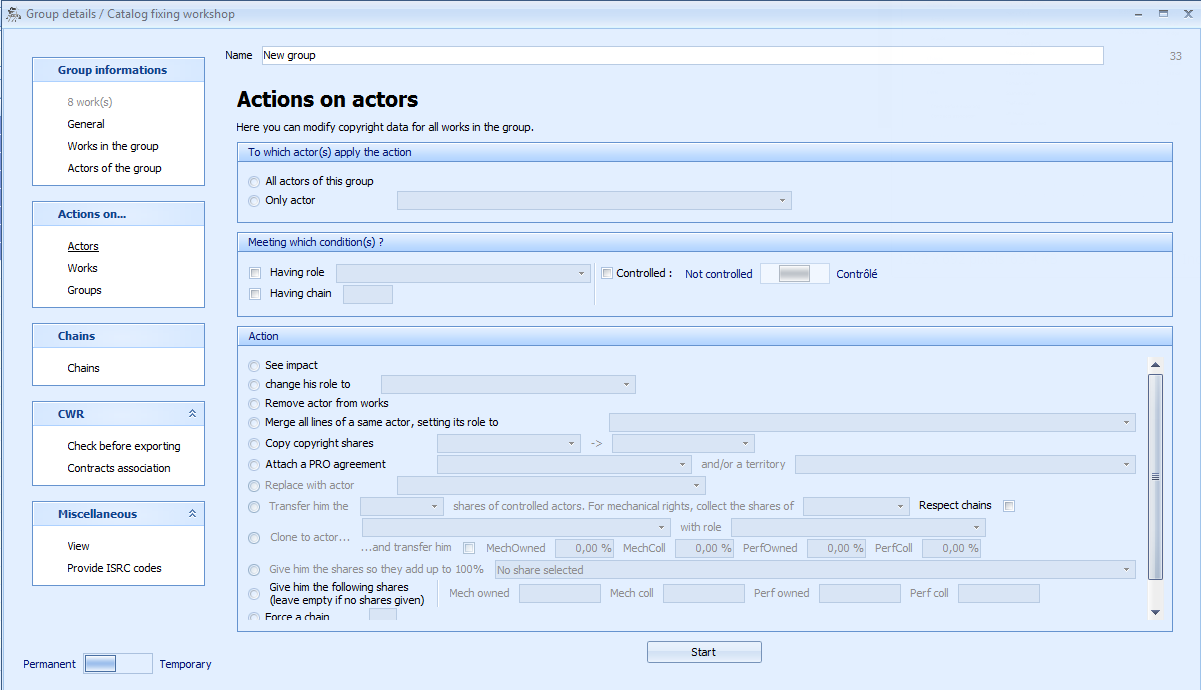Groups - Catalogue fixing workshop¶
The workshop allows the identification of groups, affiliations, and the content of works that make up the group.
The concept of Group¶
The concept of Group in Sage makes it possible to treat the contents of several works in the same way. It is through groups that we carry out analyzes, exports, attachment to contracts, etc. This concept is therefore essential.
A group is a collection of works that have at least one characteristic in common: from the same import, have the same actor, must be subject to a common action … The number of groups used is unlimited. It is important to give them a clear name.
A single work can be part of several groups: caution: do not attach conflicting information. E.g.: different contracts for royalty payments that would contradict each other.
Groups can also be temporary. Periodically, to carry out an action without keeping a trace, simply check temporary, so when you close the window the action is deleted. On closing, a pop-up message will ask you whether you wish to delete or make the group permanent.
** A group is therefore a grouping of works, permanent or temporary, allowing you to do various actions. **
These groups can be established in : the list of imports, the list of works via the advanced search, the catalogue fixing workshop by comparing two different groups or by selecting a few works in « works of the group ».
Groups¶
Groups of works have become, over time, a central element of the software. They are used for analyses, verifications and to make payments.
A group is ** static ** if it is created manually or if it is created automatically by Le Sage during an import. After its creation, you, alone, have control of the additions and deletion of works within.
By contrast, a group is ** dynamic ** if it is able to evolve (almost) on its own and therefore works are added or removed automatically. A group is dynamic when a condition is attached to it. For example, the condition can be the presence of a rightholder within the work. Imagine that we want to create a group containing all the works of an author. Open the list of actors, click right on the author and, in the menu Create a work group : Create a work group
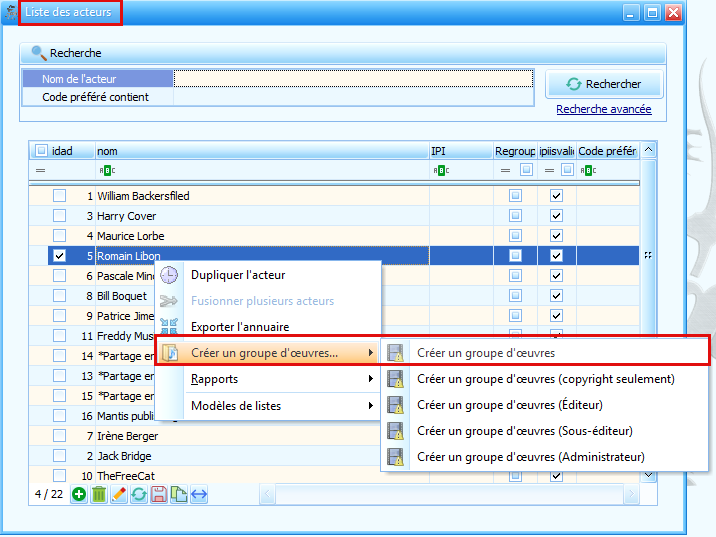
The group thus created will be dynamic and will be conditioned by the presence of this author in the works. If we now import a catalogue of SACEM and it contains new works in which this author is present, the new works will integrate the dynamic group. Sage does not automatically decide to update dynamic groups: you must click on the button rebuild all dynamic groups in the group list:
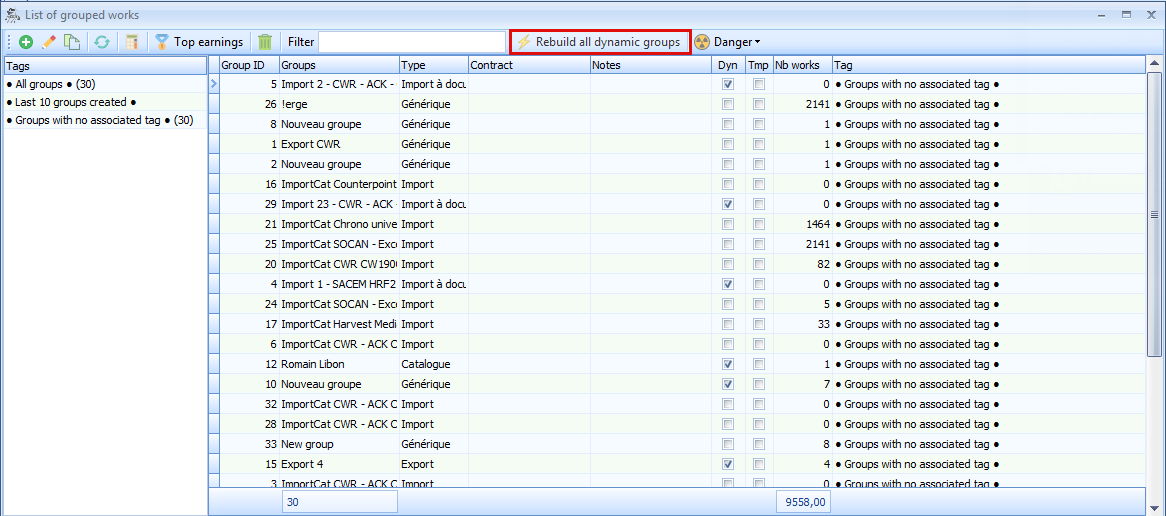
There are different conditions for forming dynamic groups:
- presence of an actor in the work
- presence of an actor in the work with a particular role
- presence of the work in a SACEM CD
- presence of the work in a SACEM film
- the work is attached to a particular company
- the work has a particular tag
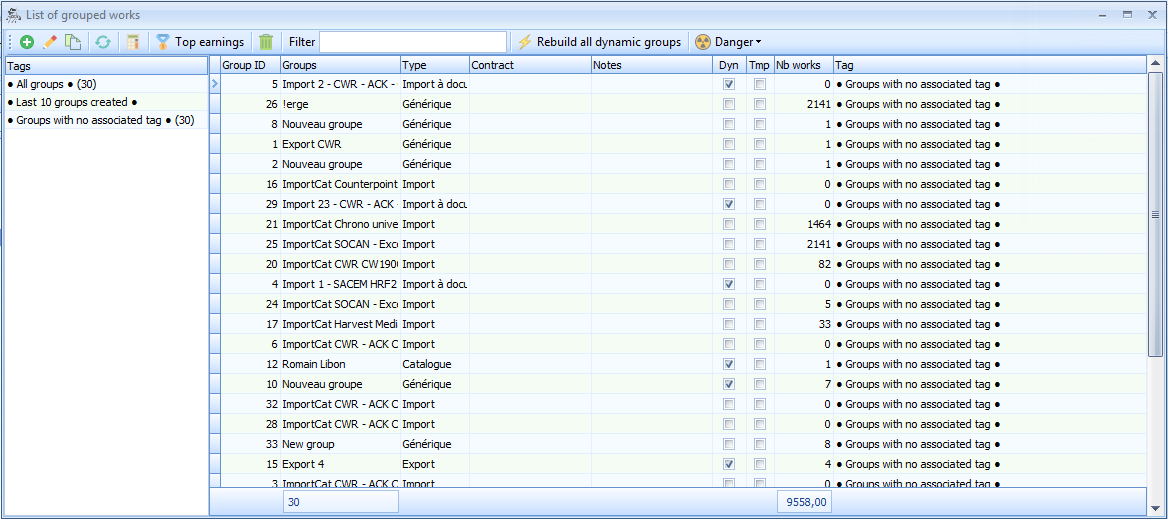
The first column indicates the group number. This number is automatically assigned by The Sage and is unchangeable. Normally, it is of no use to you directly.
Next to it, is the name of the group. The name can be changed at any time.
Then follows the type of group: essentially informative, it is used to distinguish the uses of the groups. « Import », « Film » and « Export » types are defined by The Sage, however you can change them at your convenience. ** Deposit ** is a special type: it is used to make deposits electronically. Only ** Deposit ** groups can be chosen in the HRF2 exports.
The next column indicates the contract attached to the group.
The column « Dyn » indicates if a group is « Dynamic »: the works attached to it are able to evolve automatically.
The next column shows the number of works currently attached to the group.
The Tags enable the creation of groups of groups. More on that matter in Tags
The Group’s information¶
The number of works present in the group: check and observe the number of works selected when creating the group.
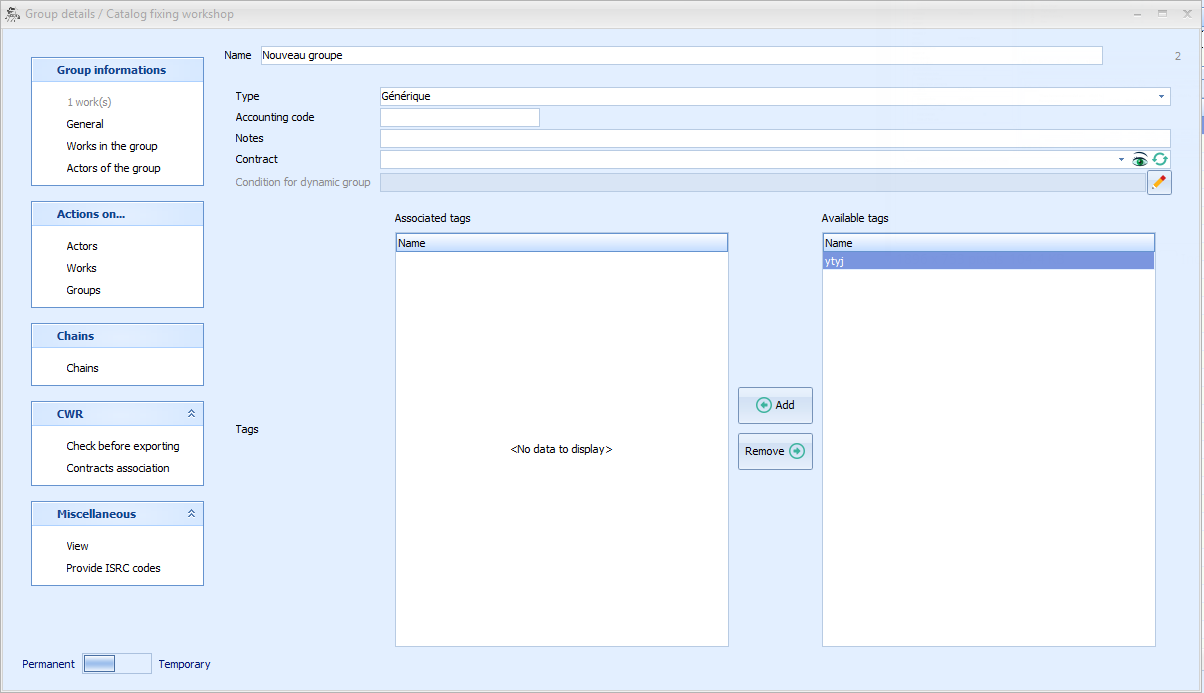
Overview¶
Group name: name identifying the group Group Type: group category. Accounting code: ?? Notes: personal note about the group. Contract: selection of a contract among those defined in the list of contracts. Information on royalties will therefore be reflected in each worksheet. Condition: the conditions make it possible to generate dynamic groups of works having a condition in common e.g. an actor, a film, a third party, a tag, etc…
Depending on the use of the group all this information is not to be entered.
Related tags / Available tags: see page :ref.:tags
Works in group¶

Presentation of the interface¶
This tab shows the list of works present in the group. - * Works list template *: This field allows you to choose from the list of available templates (see list templates page). The list changes the visible columns below. - * Secondary list template *: manages the visible information when displaying the works:
- the actors” copyrights
- the royalties
- CWR / ACK feedback messages
Possible actions¶
deleting a work in the group
open / edit: check and edit a work
Refresh
+: Displays the works to view the information according to the chosen secondary list template.
-: closes the information.
the filter: selection of works if:
- shares owned / coll different from 100%
- no actor is controlled
- in co-edition
- the lettering is incomplete
- no original publisher present
- contract with a PRO
- no contract with a PRO
- according to an IPI code
- depending on the message in CWR / ACK
Create a contract based on the royalties of a work
Optimize column widths of the selected list template
Actors in group¶
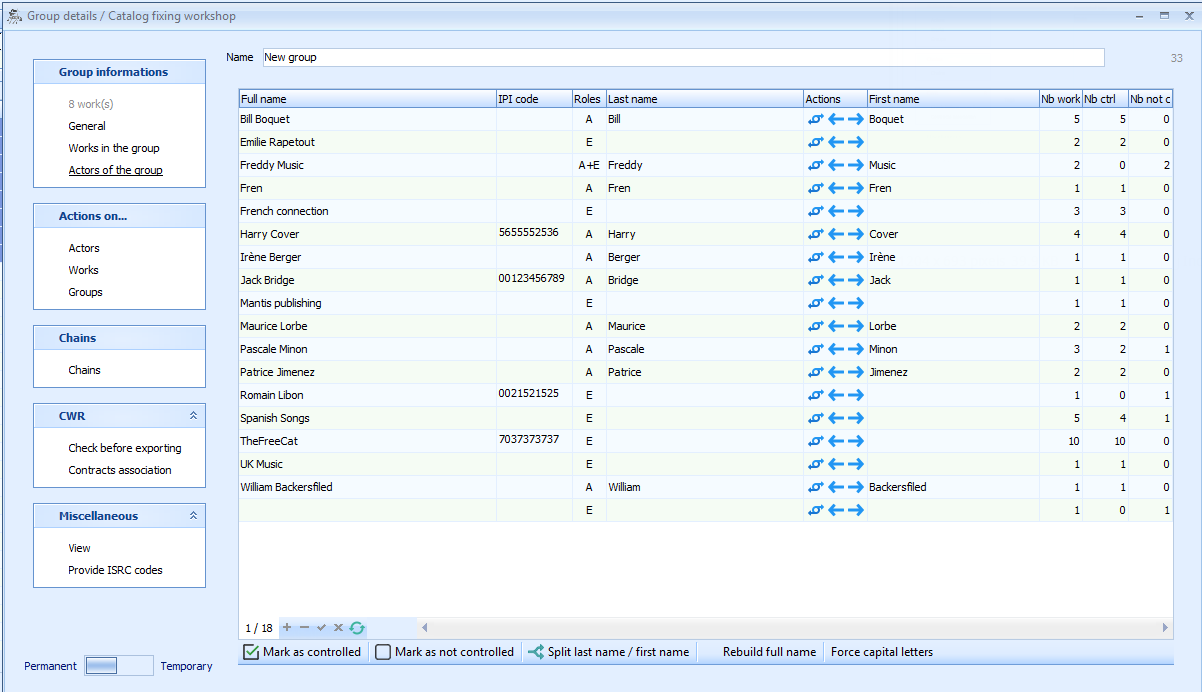
Presentation of the interface¶
These are the actors present in the works that make up the group. For each actor:
- Their full name
- their IPI code
- their role: the actor can have a different role from one work to another and even within the same work. In this case, they will appear as many times as their different roles.
- action on their part: one can choose to force shares for the DEP and Phono owned and collected
- last name
- first name
- the possibility of reversing both.
- the number of works in which the actor is ** present ** among the works of the group
- the number of works in which the actor is ** controlled ** among the works of the group
- the number of works in which the actor ** is not controlled ** among the works of the group
Possible actions¶
- Mark controlled / uncontrolled *: After having selected one or more actors it is possible to mark them as controlled or not in all the works of the group.
- Separate last name / first name: The CWR exports in particular require that the first and last names of the actors are separate. If you have not completed the name / surname section of the actor’s sheet, this action allows you to do so for all actors in the group. You can then adjust this in case Sage has identified the first name instead of the last name.
- Replicate full name: reverse action.
- Force upper case: Put all first names and last names in upper case.
Actions on group¶
These group actions make it possible to treat works collectively.
You have to be very careful about actions because you cannot undo them, or at least no history of changes is available. The data present in the worksheets and in the actors” sheet are also modified.
Works¶
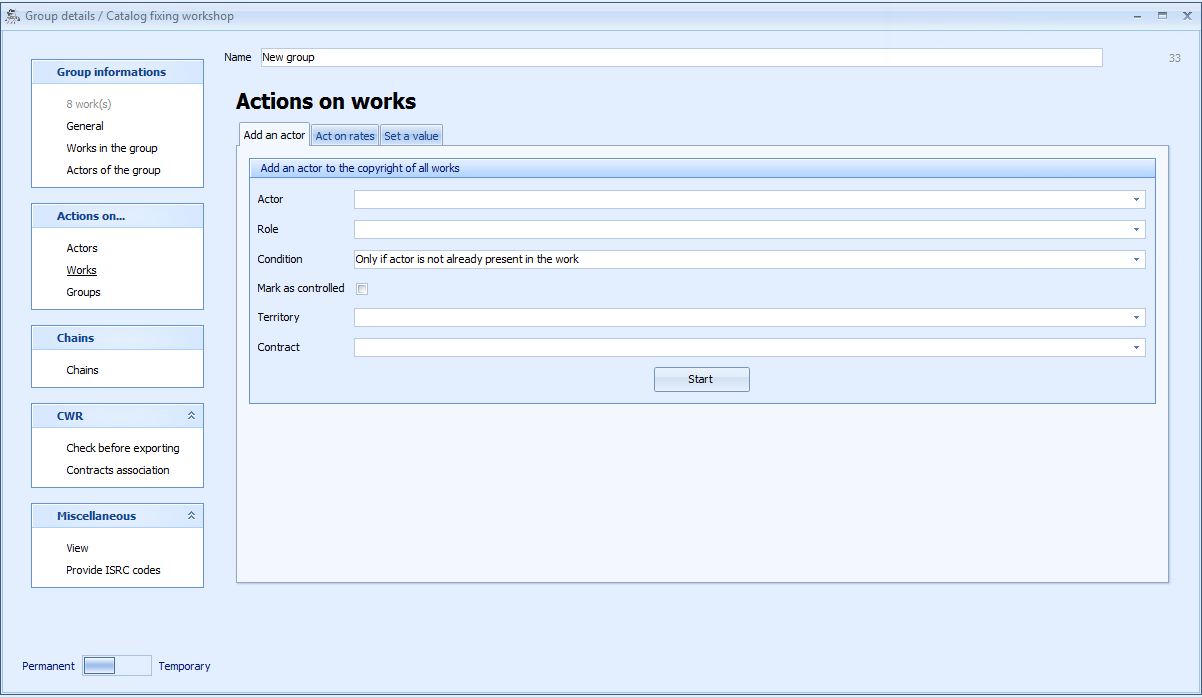
Add an actor
Act on shares :
- deduct % owned from SACEM shares : if the SACEM copyright shares are filled in, Sage will automatically deduct the perf and mech owned shares.
- Copy the % owned in % collection areas
- copy the % owned in% collection areas only for actors whose collection share is empty
- copy the% owned in% collection areas only for non-controlled actors : allows registrating the works for which we do not collect all the copyrights.
- Standardise owned / coll shares: When add-on shares are not exactly 100%, this module allows the smoothing of percentages for each share.
- Remove royalties
Groups¶
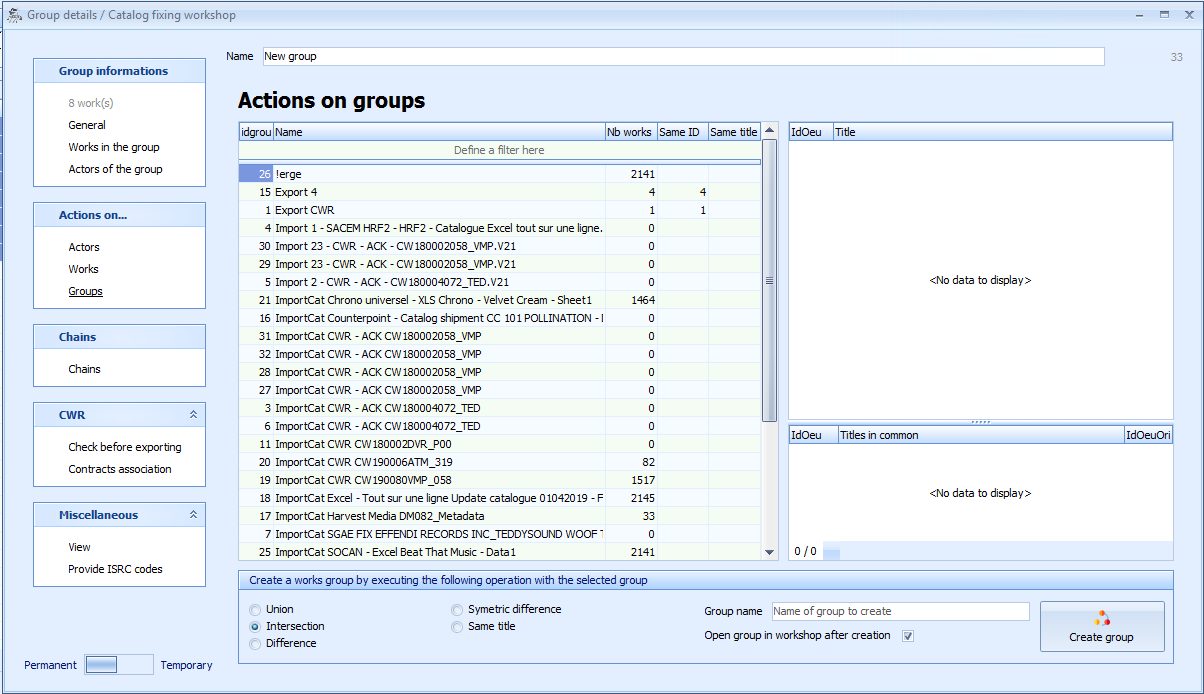
This window is dedicated to make groups of works interact.
- Union: bring together works from two different groups in one group.
- Intersection: creates a group containing the works present in both selected groups.
- Difference: creates a group of the works present in the group on which one is working but which are absent from the comparison group.
- Symmetrical difference: creates a group with all the works that are not common to both groups.
- Same title: creates a group with works that have the same title in both groups (but that are not the same work)
For each action a third group is created. It can be named via « Group Name » and opens automatically after creation by not unchecking « open the group in the workshop after creation ».
Chains of rights¶
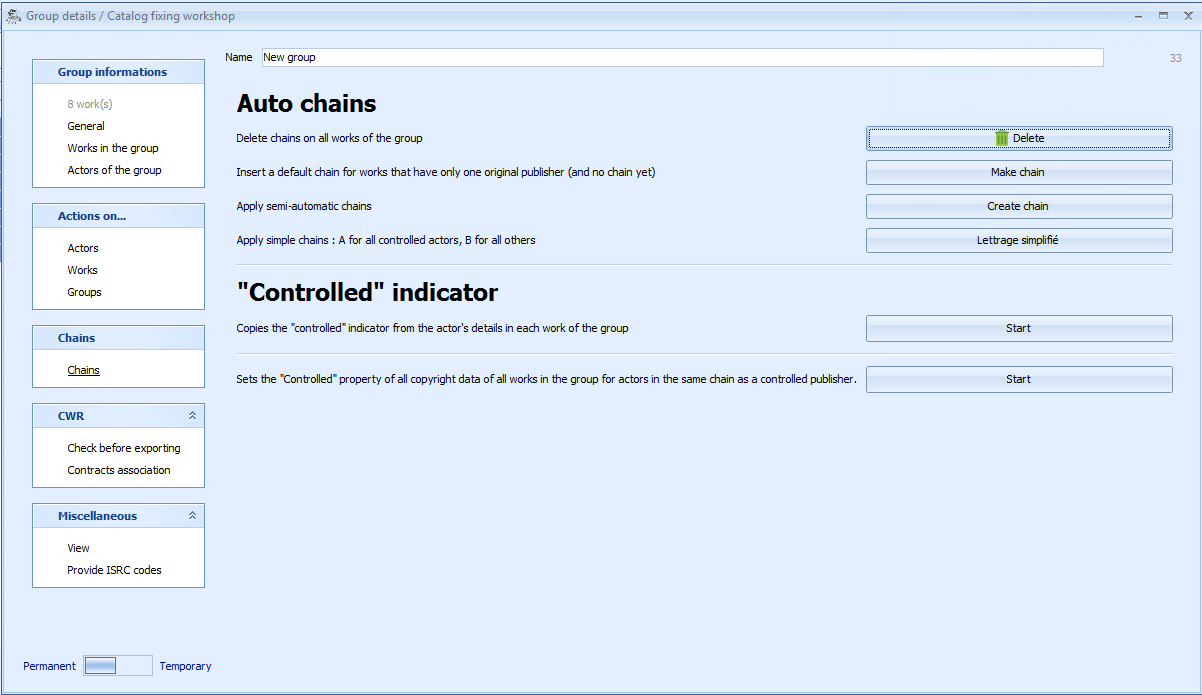
Automatic lettering system¶
Lettering (the chains of rights), can be managed by group and in an intelligent way by Sage.
- In case of error in a series of works all lettering can be cleared.
- When a work is simple with only one original editor, we can assume that all the actors present will be managed by the latter.
- Lettering, using the indication “controlled or uncontrolled actors”, does not enable you to establish all the potential detail for a group of actors within a group. However, it will make it possible to put forward only the connections concerning you. Controlled actors will automatically be lettered A and the others B.
CWR¶

Two modules are available in the workshop to check and rework your works before export:
CWR: Automatic action buttons on all the works.
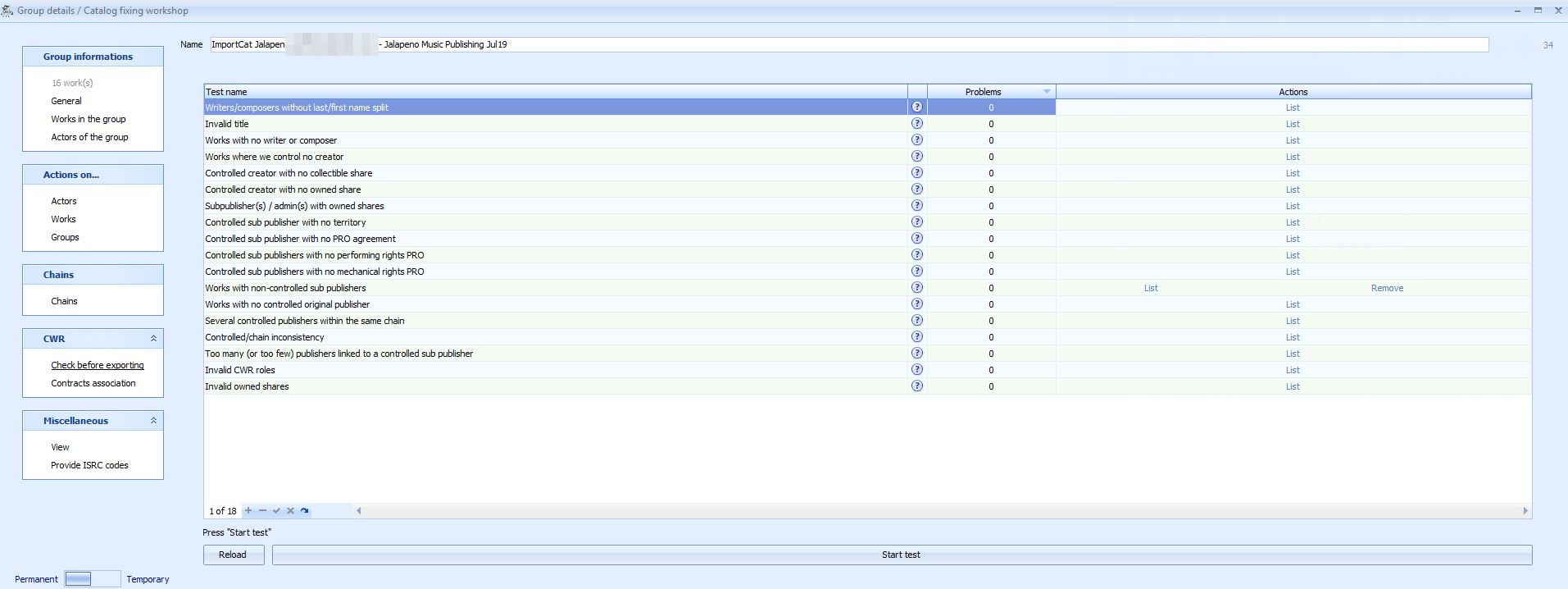
Check before export
PROs” requirements are diverse and all the points listed are not universally requested.
The idea is to detect as many errors as possible to avoid rejection of registration.
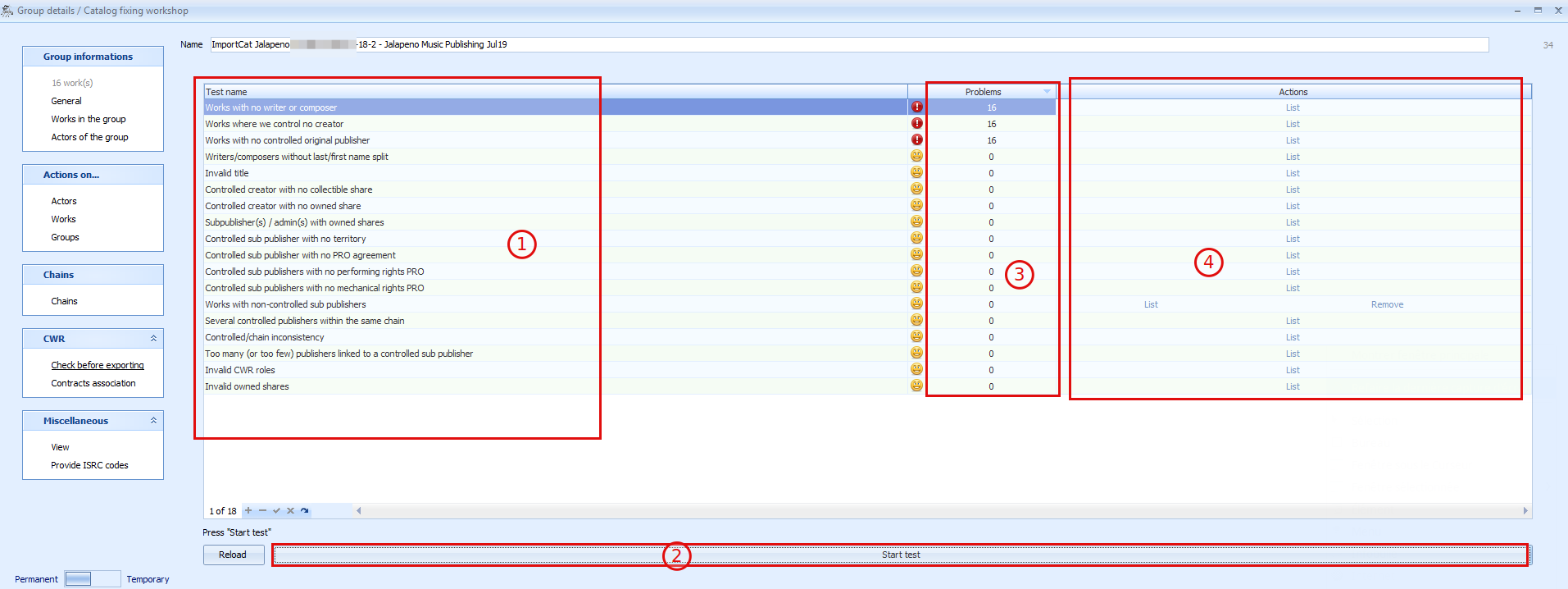
- List of detections: by putting your mouse above this list some information appears such as « Mandatory for SACEM »
- Test: to start detection press the « Test » button
- Smiling smileys indicate that there is no detectable error contrary to exclamation marks. The « defects » column gives the number of errors within detected works.
- Actions: List the “error” works to be reworked.
Controlled indicator¶
- If the information is entered in the actor’s sheet it will be copied in the different works.
- Deduction of control from the other works present in the group.
